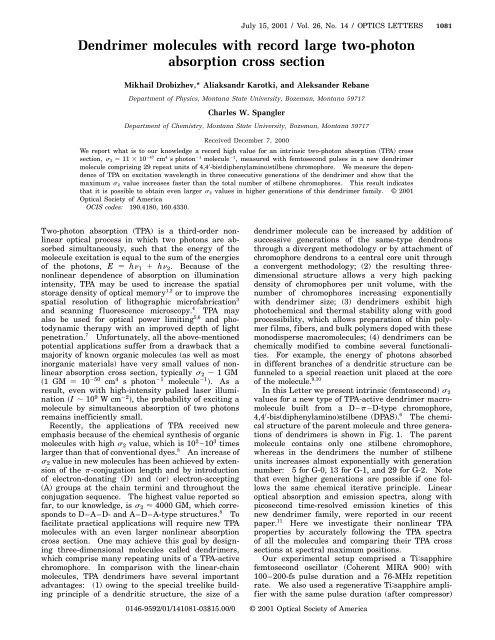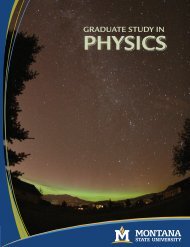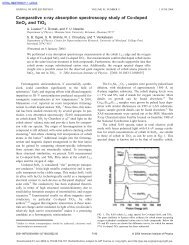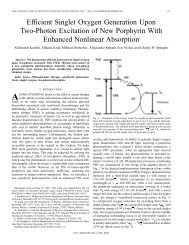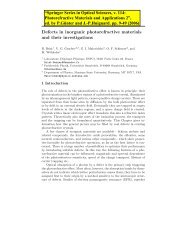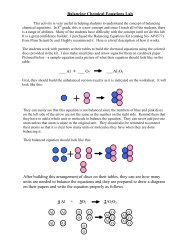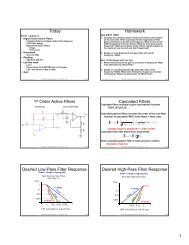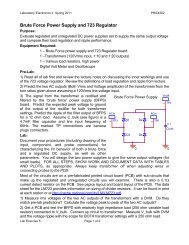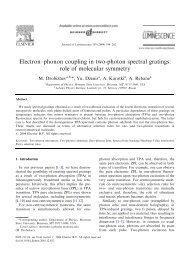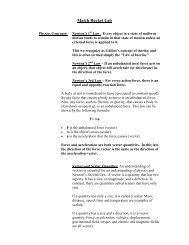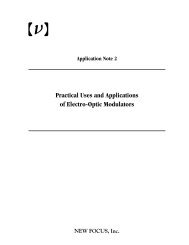July 15, 2001 / Vol. 26, No. 14 / OPTICS - Department of Physics ...
July 15, 2001 / Vol. 26, No. 14 / OPTICS - Department of Physics ...
July 15, 2001 / Vol. 26, No. 14 / OPTICS - Department of Physics ...
Create successful ePaper yourself
Turn your PDF publications into a flip-book with our unique Google optimized e-Paper software.
<strong>July</strong> <strong>15</strong>, <strong>2001</strong> / <strong>Vol</strong>. <strong>26</strong>, <strong>No</strong>. <strong>14</strong> / <strong>OPTICS</strong> LETTERS 1081<br />
Dendrimer molecules with record large two-photon<br />
absorption cross section<br />
Mikhail Drobizhev,* Aliaksandr Karotki, and Aleksander Rebane<br />
<strong>Department</strong> <strong>of</strong> <strong>Physics</strong>, Montana State University, Bozeman, Montana 59717<br />
Charles W. Spangler<br />
<strong>Department</strong> <strong>of</strong> Chemistry, Montana State University, Bozeman, Montana 59717<br />
Received December 7, 2000<br />
We report what is to our knowledge a record high value for an intrinsic two-photon absorption (TPA) cross<br />
section, s 2 11 3 10 247 cm 4 s photon 21 molecule 21 , measured with femtosecond pulses in a new dendrimer<br />
molecule comprising 29 repeat units <strong>of</strong> 4,4 0 -bis(diphenylamino)stilbene chromophore. We measure the dependence<br />
<strong>of</strong> TPA on excitation wavelength in three consecutive generations <strong>of</strong> the dendrimer and show that the<br />
maximum s 2 value increases faster than the total number <strong>of</strong> stilbene chromophores. This result indicates<br />
that it is possible to obtain even larger s 2 values in higher generations <strong>of</strong> this dendrimer family. © <strong>2001</strong><br />
Optical Society <strong>of</strong> America<br />
OCIS codes: 190.4180, 160.4330.<br />
Two-photon absorption (TPA) is a third-order nonlinear<br />
optical process in which two photons are absorbed<br />
simultaneously, such that the energy <strong>of</strong> the<br />
molecule excitation is equal to the sum <strong>of</strong> the energies<br />
<strong>of</strong> the photons, E hn 1 1 hn 2 . Because <strong>of</strong> the<br />
nonlinear dependence <strong>of</strong> absorption on illumination<br />
intensity, TPA may be used to increase the spatial<br />
storage density <strong>of</strong> optical memory 1,2 or to improve the<br />
spatial resolution <strong>of</strong> lithographic micr<strong>of</strong>abrication 3<br />
and scanning f luorescence microscopy. 4 TPA may<br />
also be used for optical power limiting 5,6 and photodynamic<br />
therapy with an improved depth <strong>of</strong> light<br />
penetration. 7 Unfortunately, all the above-mentioned<br />
potential applications suffer from a drawback that a<br />
majority <strong>of</strong> known organic molecules (as well as most<br />
inorganic materials) have very small values <strong>of</strong> nonlinear<br />
absorption cross section, typically s 2 1 GM<br />
1 GM 10 250 cm 4 s photon 21 molecule 21 . As a<br />
result, even with high-intensity pulsed laser illumination<br />
I 10 9 Wcm 22 , the probability <strong>of</strong> exciting a<br />
molecule by simultaneous absorption <strong>of</strong> two photons<br />
remains inefficiently small.<br />
Recently, the applications <strong>of</strong> TPA received new<br />
emphasis because <strong>of</strong> the chemical synthesis <strong>of</strong> organic<br />
molecules with high s 2 value, which is 10 2 10 3 times<br />
larger than that <strong>of</strong> conventional dyes. 8 An increase <strong>of</strong><br />
s 2 value in new molecules has been achieved by extension<br />
<strong>of</strong> the p-conjugation length and by introduction<br />
<strong>of</strong> electron-donating (D) and (or) electron-accepting<br />
(A) groups at the chain termini and throughout the<br />
conjugation sequence. The highest value reported so<br />
far, to our knowledge, is s 2 4000 GM, which corresponds<br />
to D–A–D- and A–D–A-type structures. 8 To<br />
facilitate practical applications will require new TPA<br />
molecules with an even larger nonlinear absorption<br />
cross section. One may achieve this goal by designing<br />
three-dimensional molecules called dendrimers,<br />
which comprise many repeating units <strong>of</strong> a TPA-active<br />
chromophore. In comparison with the linear-chain<br />
molecules, TPA dendrimers have several important<br />
advantages: (1) owing to the special treelike building<br />
principle <strong>of</strong> a dendritic structure, the size <strong>of</strong> a<br />
dendrimer molecule can be increased by addition <strong>of</strong><br />
successive generations <strong>of</strong> the same-type dendrons<br />
through a divergent methodology or by attachment <strong>of</strong><br />
chromophore dendrons to a central core unit through<br />
a convergent methodology; (2) the resulting threedimensional<br />
structure allows a very high packing<br />
density <strong>of</strong> chromophores per unit volume, with the<br />
number <strong>of</strong> chromophores increasing exponentially<br />
with dendrimer size; (3) dendrimers exhibit high<br />
photochemical and thermal stability along with good<br />
processibility, which allows preparation <strong>of</strong> thin polymer<br />
films, fibers, and bulk polymers doped with these<br />
monodisperse macromolecules; (4) dendrimers can be<br />
chemically modified to combine several functionalities.<br />
For example, the energy <strong>of</strong> photons absorbed<br />
in different branches <strong>of</strong> a dendritic structure can be<br />
funneled to a special reaction unit placed at the core<br />
<strong>of</strong> the molecule. 9,10<br />
In this Letter we present intrinsic (femtosecond) s 2<br />
values for a new type <strong>of</strong> TPA-active dendrimer macromolecule<br />
built from a D p D-type chromophore,<br />
4,4 0 -bis(diphenylamino)stilbene (DPAS). 6 The chemical<br />
structure <strong>of</strong> the parent molecule and three generations<br />
<strong>of</strong> dendrimers is shown in Fig. 1. The parent<br />
molecule contains only one stilbene chromophore,<br />
whereas in the dendrimers the number <strong>of</strong> stilbene<br />
units increases almost exponentially with generation<br />
number: 5 for G-0, 13 for G-1, and 29 for G-2. <strong>No</strong>te<br />
that even higher generations are possible if one follows<br />
the same chemical iterative principle. Linear<br />
optical absorption and emission spectra, along with<br />
picosecond time-resolved emission kinetics <strong>of</strong> this<br />
new dendrimer family, were reported in our recent<br />
paper. 11 Here we investigate their nonlinear TPA<br />
properties by accurately following the TPA spectra<br />
<strong>of</strong> all the molecules and comparing their TPA cross<br />
sections at spectral maximum positions.<br />
Our experimental setup comprised a Ti:sapphire<br />
femtosecond oscillator (Coherent MIRA 900) with<br />
100–200-fs pulse duration and a 76-MHz repetition<br />
rate. We also used a regenerative Ti:sapphire amplifier<br />
with the same pulse duration (after compressor)<br />
0<strong>14</strong>6-9592/01/<strong>14</strong>1081-03$<strong>15</strong>.00/0 © <strong>2001</strong> Optical Society <strong>of</strong> America
1082 <strong>OPTICS</strong> LETTERS / <strong>Vol</strong>. <strong>26</strong>, <strong>No</strong>. <strong>14</strong> / <strong>July</strong> <strong>15</strong>, <strong>2001</strong><br />
Fig. 1. Chemical structure <strong>of</strong> three generations <strong>of</strong> dendrimers,<br />
G-0, G-1, and G-2, and the DPAS parent chromophore<br />
molecule.<br />
and a 1-kHz repetition rate. Fluorescence intensity<br />
was measured with a digital CCD camera (Xillix<br />
Microimager), and spectra were measured with<br />
a Jobin–Yvon TRIAX 550 spectrometer. For<br />
sample preparation, the molecules were dissolved<br />
in dichloromethane in a standard 2-mm-thick spectroscopic<br />
cell. A fresh solution was prepared for every<br />
experiment.<br />
In our experiment we employed the fundamental<br />
wavelength <strong>of</strong> the femtosecond Ti:sapphire laser for<br />
two-photon excitation and the second harmonic <strong>of</strong> the<br />
same laser for one-photon excitation. In both cases,<br />
the beam was slightly focused with an f 500 mm<br />
lens onto the sample through a pinhole placed in front<br />
<strong>of</strong> the lens. A stack <strong>of</strong> colored-glass filters cut <strong>of</strong>f scattered<br />
laser light.<br />
For the measurement <strong>of</strong> the relative TPA cross section<br />
we used a f luorescence method 12 in which the f luorescence<br />
signal intensities obtained from two-photon<br />
excitation <strong>of</strong> unknown and reference molecules at the<br />
same conditions are compared. The relative TPA cross<br />
section <strong>of</strong> an unknown compound is then proportional<br />
to its f luorescence emission intensity divided by the<br />
f luorescence quantum yield.<br />
We checked that, upon two-photon excitation, the<br />
f luorescence spectra <strong>of</strong> all the substances are the same<br />
as those obtained with one-photon excitation. Therefore<br />
the same electronic state is responsible for emission<br />
after either one- or two-photon excitation. For<br />
DPAS, the absolute value <strong>of</strong> the f luorescence quantum<br />
yield was reported to be 0.87. 13 Fluorescence yields for<br />
all dendrimers are measured by a standard one-photon<br />
excitation procedure, relative to DPAS, and are presented<br />
in Table 1.<br />
Figure 2 shows the dependence <strong>of</strong> the TPA cross<br />
section on laser wavelength for three dendrimer generations<br />
and for the parent DPAS molecule. To obtain<br />
these spectra we normalized the f luorescence signal<br />
to inverse pulse duration 12 at each wavelength <strong>of</strong> the<br />
Ti:sapphire femtosecond oscillator. Since the spectral<br />
peaks for all three dendrimers lie in the region<br />
710–7<strong>15</strong> nm, we measured the f luorescence signal<br />
at 7<strong>14</strong> nm for all the molecules at equal conditions.<br />
Then the signal was normalized to the f luorescence<br />
quantum yield and the molar concentration <strong>of</strong> a particular<br />
molecule. We calculated absolute s 2 values<br />
for the dendrimers by taking s 2 325 GM as a reference,<br />
which was measured previously with picosecond<br />
pulses for the DPAS peak value. <strong>14</strong> The peak TPA<br />
cross sections for our dendrimers are presented in<br />
Table 1.<br />
The highest intrinsic s 2 values measured previously<br />
with 100-fs excitation pulses <strong>of</strong> which we are aware,<br />
s 2 3700 GM, belongs to a substituted bis(styryl)benzene.<br />
8 The cross section <strong>of</strong> our G-2 dendrimer, s 2 <br />
11 3 10 3 GM, is three times greater, thus presenting,<br />
to our best knowledge, the record high value for a<br />
monodisperse organic macromolecule. We emphasize<br />
here that, for nanosecond pulses, even higher effective<br />
cross sections were reported (see, for example, Ref. <strong>15</strong>),<br />
but they included an absorption from the excited-state<br />
populated after the direct TPA process. 16 Although we<br />
have also found some contribution <strong>of</strong> excited-state absorption<br />
when we use 76-MHz repetition-rate pulses<br />
from the oscillator, this absorption can be avoided by<br />
use <strong>of</strong> 1-kHz repetition-rate pulses from the amplifier.<br />
So the record value <strong>of</strong> s 2 mentioned above, as well as<br />
all other s 2 values presented in Table 1, corresponds<br />
to intrinsic TPA.<br />
TPA maximum <strong>of</strong> G-1 and G-2 dendrimers in Fig. 2<br />
is clearly redshifted with respect to DPAS. This<br />
Table 1. One-Photon (Linear) and Two-Photon (TPA) Peak Positions l max , Absolute Fluorescence<br />
Quantum Yields h, and Peak TPA Cross-Section Values <strong>of</strong> DPAS and the Dendrimers<br />
l max nm<br />
Molecule Number <strong>of</strong> Stilbenes Linear TPA h s 2 GM a<br />
DPAS 1 392 690 b 0.87 325 b<br />
G-0 5 416 705 6 10 0.52 2800<br />
G-1 13 413 7<strong>14</strong> 6 2 0.81 4500<br />
G-2 29 419 713 6 2 0.55 11,000<br />
a The error <strong>of</strong> measurement <strong>of</strong> s 2 is 10%.<br />
b Obtained from the data in Ref. <strong>14</strong>.
<strong>July</strong> <strong>15</strong>, <strong>2001</strong> / <strong>Vol</strong>. <strong>26</strong>, <strong>No</strong>. <strong>14</strong> / <strong>OPTICS</strong> LETTERS 1083<br />
a dendrimer but jumps when going from the parent<br />
DPAS molecule to the first, G-0 generation. For the<br />
largest dendrimer studied, G-2, the cross section <strong>of</strong><br />
11 3 10 3 GM is to our knowledge the highest intrinsic<br />
value obtained so far for an organic molecule. We<br />
have also shown that these new dendrimers possess<br />
high quantum yields <strong>of</strong> f luorescence, which is important<br />
for several applications.<br />
This work was supported by U.S. Air Force Office<br />
<strong>of</strong> Scientific Research grants F49620-96-1-0440,<br />
F49620-98-1-0422, and F49620-98-1-0<strong>15</strong>7. A. Rebane’s<br />
e-mail address is rebane@physics.montana.edu.<br />
*Permanent address, Lebedev <strong>Physics</strong> Institute,<br />
Leninsky Prospekt 53, 117924 Moscow, Russia.<br />
References<br />
Fig. 2. TPA spectra <strong>of</strong> G-0 (squares), G-1 (downward<br />
triangles), and G-2 (upward triangles) dendrimers. Solid<br />
curves, Lorentzian fit to experimental data. The TPA<br />
spectrum <strong>of</strong> the parent molecule DPAS is presented for<br />
comparison (filled circles). Open ovals, data from Ref. <strong>14</strong>.<br />
Dashed curve, rescaled linear absorption <strong>of</strong> G-2. The<br />
real wavelength for this spectrum is one-half the abscissa<br />
value. Inset, dependence <strong>of</strong> the peak TPA cross section<br />
on the total number <strong>of</strong> stilbene moieties in a dendrimer<br />
molecule. Solid line, the best linear fit. Dashed line,<br />
thermodynamic limit <strong>of</strong> a collection <strong>of</strong> noninteracting<br />
chromophores.<br />
shift, as well as a similar redshift in the linear<br />
absorption, 11 suggests either dipole–dipole-type 17 or<br />
p-conjugation-type 18 interaction between the dendrimer’s<br />
branches.<br />
The inset <strong>of</strong> Fig. 2 shows the TPA peak cross section<br />
for one dendrimer molecule as a function <strong>of</strong> the<br />
total number <strong>of</strong> stilbene moieties, N. As one can see,<br />
the dependence is very close to linear. Although the<br />
peak position for the G-0 dendrimer is not accurately<br />
defined, we can estimate it by fitting the experimental<br />
spectrum to a model Lorentzian distribution. It is interesting<br />
that the lowest estimate for s 2 is still eight<br />
times higher than that <strong>of</strong> DPAS, whereas the number<br />
<strong>of</strong> stilbenes in G-0 is only five times higher. We have<br />
drawn in the same plot a dashed line for s 2 325 N,<br />
which corresponds to the case when cross sections <strong>of</strong><br />
dendrimer-constituent stilbenes simply add together.<br />
Here we again notice evidence <strong>of</strong> a cooperative effect<br />
between segments in the G-0 dendrimer, which saturates<br />
in higher generations. In previous studies <strong>of</strong><br />
oligomer 17 and dendrimer 18 molecules containing TPA<br />
chromophores, the authors also observed an increase<br />
<strong>of</strong> molecular TPA cross sections with the number <strong>of</strong><br />
chromophores per molecule, but the cross sections were<br />
measured at only one wavelength.<br />
In conclusion, we have studied two-photon absorption<br />
spectra in three generations <strong>of</strong> dendrimers based<br />
on 4,4 0 -bis(diphenylamino)stilbene repeat units. The<br />
peak femtosecond two-photon cross section increases<br />
almost linearly with the number <strong>of</strong> chromophores in<br />
1. D. A. Partenopoulos and P. M. Rentzepis, Science 245,<br />
843 (1989).<br />
2. J. H. Strickler and W. W. Webb, Opt. Lett. 16, 1780<br />
(1991).<br />
3. B. H. Cumpston, S. P. Ananthavel, S. Barlow, D. L.<br />
Dyer, J. E. Ehrlich, L. L. Erskine, A. A. Heikal,<br />
S. M. Kuebler, I.-Y. S. Lee, D. McCord-Maughon, J.<br />
Qin, H. Röckel, M. Rumi, X.-L. Wu, S. R. Marder, and<br />
J. W. Perry, Nature 398, 51 (1999).<br />
4. W. Denk, J. H. Strickler, and W. W. Webb, Science 248,<br />
73 (1990).<br />
5. G. S. He, G. C. Xu, P. N. Prasad, B. A. Reinhardt, J. C.<br />
Bhatt, A. G. Dillard, and R. McKellar, Opt. Lett. 20,<br />
435 (1995).<br />
6. C. W. Spangler, J. Mater. Chem. 9, 2013 (1999).<br />
7. J. D. Bhawalkar, N. D. Kumar, C.-F. Zhao, and P. N.<br />
Prasad, J. Clin. Laser Med. Surg. <strong>15</strong>, 201 (1997).<br />
8. M. Albota, D. Beljonne, J.-L. Brédas, J. E. Ehrlich, J.-Y.<br />
Fu, A. A. Heikal, S. E. Hess, T. Kogej, M. D. Levin, S. R.<br />
Marder, D. McCord-Maughon, J. W. Perry, H. Röckel,<br />
M. Rumi, G. Subramaniam, W. W. Webb, X.-L. Wu, and<br />
C. Xu, Science 281, 1653 (1998).<br />
9. C. Devadoss, P. Bharathi, and J. S. Moore, J. Am.<br />
Chem. Soc. 118, 9635 (1996).<br />
10. A. Bar-Haim, J. Klafter, and R. Kopelman, J. Am.<br />
Chem. Soc. 119, 6197 (1997).<br />
11. M. Drobizhev, A. Rebane, C. Sigel, E. H. Elandaloussi,<br />
and C. W. Spangler, Chem. Phys. Lett. 325, 375 (2000).<br />
12. M. A. Albota, C. Xu, and W. W. Webb, Appl. Opt. 37,<br />
7352 (1998).<br />
13. M. Rumi, J. E. Ehrlich, A. A. Heikal, J. W. Perry, S.<br />
Barlow, Z. Hu, D. McCord-Maughon, T. C. Parker, H.<br />
Rocker, S. Thayumanavan, S. R. Maroler, D. Beljonne,<br />
and J.-L. Brédas, J. Am. Chem. Soc. 122, 9500 (2000).<br />
<strong>14</strong>. J. E. Ehrlich, X. L. Wu, I.-Y. S. Lee, Z.-Y. Hu, H. Röckel,<br />
S. R. Marder, and J. W. Perry, Opt. Lett. 22, 1843<br />
(1997).<br />
<strong>15</strong>. G. S. He, L. Yuan, N. Cheng, J. D. Bhawalkar, P. N.<br />
Prasad, L. L. Brott, S. Clarson, and B. A. Reinhardt,<br />
J. Opt. Soc. Am. B <strong>14</strong>, 1079 (1997).<br />
16. J. Swiatkiewcz, P. N. Prasad, and B. A. Reinhardt, Opt.<br />
Commun. <strong>15</strong>7, 135 (1998).<br />
17. S.-J. Chung, K.-S. Kim, T.-C. Lin, G. S. He, J.<br />
Swiatkiewicz, and P. N. Prasad, J. Phys. Chem. B<br />
103, 10741 (1999).<br />
18. A. Adronov, J. M. J. Fréchet, G. S. He, K.-S. Kim,<br />
S.-J. Chung, J. Swiatkiewicz, and P. N. Prasad, Chem.<br />
Mater. 12, 2838 (2000).


